by
Christophe Ginter
(click on photos to enlarge image)
THE FORGOTTEN SILVERSMITHS OF
FRENCH REVOLUTION
Paris hallmarks 1788-1793
The objective of this article is the
identification of Paris silversmiths whose activity has been 'forgotten'
as their marks were never registered, due to the disorder caused
by the French Revolution of July 14, 1789. To my knowledge,
these silversmiths aren't listed in any bibliographic record and
this article is a small contribute to rehabilitate their
activity of skilled craftsmen. Their marks are well presents on
silverware owned by French and foreigners collectors, often
unsure about the authenticity of their silver punched with
unidentified marks never subjected to registration.
The marks of these silversmiths are presents on objects produced
in Paris between 1788 and 1792, with a punch called "de Bernier"
consisting of a letter "P" (for Paris).
The hallmarks of Paris 1788-1793 warranty mark
On November 12, 1788, was registered in Paris a
hallmark with the letter "P" under a royal crown and
a well readable thousandth "88". This hallmark is
also described as "P 88".
This mark was used until September 5, 1789
Obviously this was the hallmark active when French
Revolution broke out on July 14, 1789. It was
accompanied with three other marks:
- silversmith's mark (poinçon de l'orfèvre)
- charge mark (poinçon de charge), a stylized "A"
inside an oval (meaning that the piece had been
declared to the tax authorities)
- discharge mark (poinçon de décharge), a vine's or
oak's leaf (meaning that the tax was paid).
|
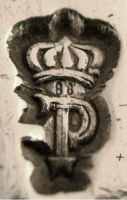 |
On September 5, 1789 was activated a new
hallmark, the letter "P" under a royal crown and the
thousandth "89" (this mark is described also as "P
89"). Notwithstanding the silversmiths' guild of
Paris was abolished in March 1791, this mark
continued to be used until April 1793, when tools
and all precious metals were confiscated to the
silversmiths during the "Terreur".
Only in 1797 a new hallmarking system was
reintroduced.
|
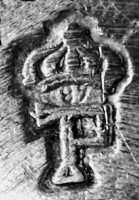 |
This was a troubled period in the
history of France, complicated by various controversies between
silversmiths and the royal authority. The result was that in
1789 numerous silversmiths avoided to register (becoming "forgotten
silversmiths") and others left in their marks any representation
of the old monarchy (1791).
Marks of unidentified silversmiths
Illustrated directory of Paris
silversmiths of the period 1789-1791 still now unknown,
 |
Mark = DA and star under crowned fleur de lys.
Silversmith's mark found on flatware bearing "P 89"
mark.
Mark of this silversmith isn't recorded after 1798 (period
"au 1er coq").
|
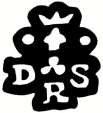 |
Mark = (D trefoil S) under crowned fleur de lys,
R on the bottom.
Silversmith's mark found on silverware bearing "P
88" mark.
Mark of this silversmith isn't recorded after 1798 (period
"au 1er coq").
|
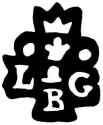 |
Mark = (L unidentified symbol G) under crowned
fleur de lys, B on the bottom.
Silversmith's mark found on silverware bearing "P
89" mark.
Mark of this silversmith isn't recorded after 1798 (period
"au 1er coq").
|
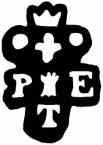 |
Mark = (P a sheaf E) under crowned fleur de lys,
T on the bottom.
Silversmith's mark found on various silverware
pieces bearing "P 89" mark.
Mark of this silversmith isn't recorded after 1798 (period
"au 1er coq").
|
 |
Mark = (N dot V) under crowned fleur de lys.
Silversmith's mark found on various silverware
pieces bearing "P 89" mark.
It's a second not registered mark either of Nicolas
Vial (entered in 1781, still quoted in 1793?) or of
Nicolas Vatinelle entered in 1769, still quoted in
1791?).
|
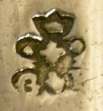 |
Mark = (G fleur de lys -possibly- and another
rubbed letter -possibly a P-)
Silversmith's mark found on a piece bearing "P 89"
mark.
The mark can be truncated.
This silversmith isn't quoted as active in 1798.
|
Other silversmiths using a "revolutionary" mark (1791-1793)
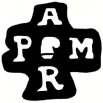 |
Mark = A over (P revolutionary cap M), R on the
bottom.
Silversmith: Augustin Philippe MOCQUIN, said "Rogeland",
entered in 1771, quoted as active in 1793.
His previous 1771 mark is unknown.
This silversmith isn't quoted as active in 1798.
Mark found together with "P 89" mark.
|
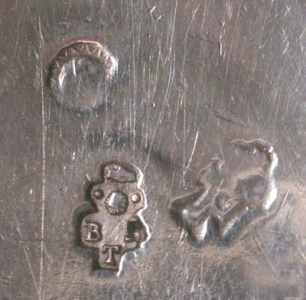 |
Silversmith's mark not identified, possibly BTT
without the royal symbols of the 'Ancien Régime' (fleur
de lys and crown).
Mark "P 89", charge mark rubbed, letter "A" inside
an oval.
This silversmith was still active in 1798. No
further information is available.
|
Conclusion
Most of the observations cited in this article were made
after the examination of pieces of minor silverware (spoons,
forks, little cups). This minimizes the possibility of
counterfeits.
Despite its historical interest, the study of French
revolutionary period and its silverware production remains
largely unexplored.
|
|
